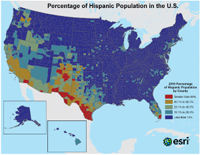ArcNews Online
Fall 2010
[an error occurred while processing this directive]Trends from Esri's 2010/2015 Updated Demographics Data

The Hispanic population in the United States—50.5 million in 2010—comprises 16.2 percent of the population and is growing at a rate of more than 3.5 percent annually.
Lingering effects of the recession—high unemployment, stagnant household incomes, and lower housing prices—continue to drag economic recovery in 2010. Even though some economists and Wall Street mavens say that technically the Great Recession may be over, the crash is still severely impacting Main Street. The end of the recession is good news for business, but this growth has yet to help the average consumer. Housing prices continue to drop, jobs are scarce, and consumers are shopping only when necessary. How do these issues translate across the country? Esri's 2010/2015 Updated Demographics data provides clear information about the 2010 demographic landscape in the United States.
Esri's 2010/2015 Updated Demographics data offers more than 2,000 data variables, including current-year estimates and 2015 forecasts for 11 different U.S. geographies from national to block group levels. Demographic data categories include Population, Households, Income, and Housing. This data helps identify areas of high unemployment, adjustments in the housing market, rising vacancy rates, changes in income and consumer spending, and increased population diversity. Agencies, businesses, and organizations use the data to analyze trends, identify growth, and reveal new market opportunities. Current data can track critical changes and preclude the cost of being wrong.
Economic Trends
Many states and cities are suffering from severe budget shortfalls due to declining tax receipts. Consumers aren't shopping as often and homes are being foreclosed, so governments are losing revenue from lower sales and property tax collection. Commercial real estate is also suffering as storefronts remain empty and dark. Banks are still cautious about lending.
Income
U.S. households are still feeling the pinch of the recession. The median household income for 2010 is $54,442, down slightly from $54,719 in 2009. In 98 percent of U.S. counties, the median household income has declined. Average household income dropped even more, falling from $71,437 to $70,135.
Housing
The first quarter of 2010 saw foreclosures jump by 16 percent over the comparable period in 2009. Short sales are still impacting the market in some areas. Housing unit vacancies rose by 7.4 percent, pushing the overall U.S. vacancy rate to nearly 12 percent.
Population
The U.S. population continues to change and diversify. In 2010, the median age in the United States is 37 years. Population growth and change slowed in most markets due to fewer births and the inability to move due to low home values and unemployment. Ten states, including Florida and Michigan, lost population from 2009 to 2010; more than half of all U.S. counties also lost population.
Diversity
The Diversity Index for the United States in 2010 is 61. The Diversity Index from Esri represents the likelihood that two persons, chosen at random from the same area, belong to different race or ethnic groups. Ethnic diversity as well as racial diversity is included in our definition of the Diversity Index. In 2010, the most diverse states are California, Hawaii, New Mexico, Texas, and Nevada. At 50.5 million, Hispanics now comprise 16.2 percent of the total U.S. population. From 2000 to 2010, this segment grew at an annual rate of 3.5 percent. The Asian population rose and now stands at 14.1 million, comprising 4.5 percent of the U.S. population. This segment grew at an annual rate of 3.2 percent from 2000 to 2010. Now numbering 9.3 million people and 3 percent of the U.S. total, the 2010 multiracial population also expanded and grew at an annual rate of 3.1 percent from 2000 to 2010.
More Information
For more information about Esri's 2010/2015 Updated Demographics data, visit www.esri.com/datawhatsnew or call 1-800-447-9778.